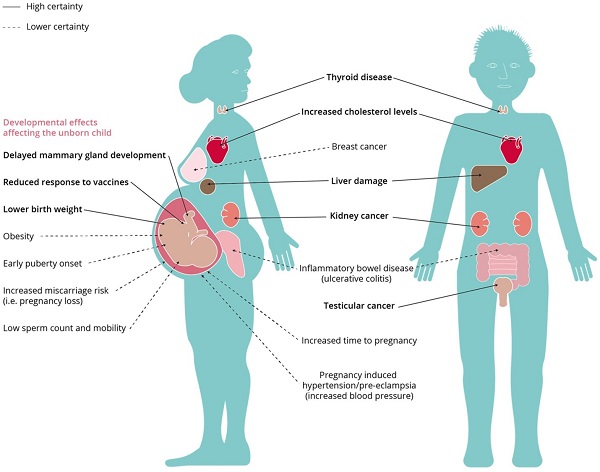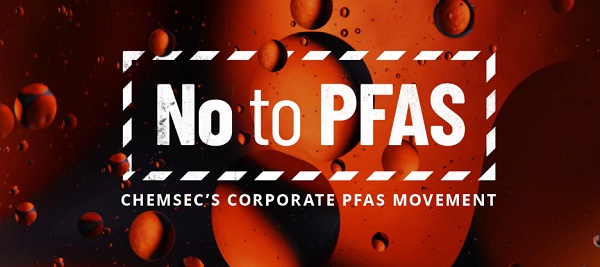Positive Health Online
Your Country

PFAS – The Unfolding Chemical Disaster
by Dr Robert Verkerk(more info)
listed in environmental, originally published in issue 292 - February 2024
Originally Published on: anhinternational.org
https://www.anhinternational.org/news/pfas-the-unfolding-chemical-disaster/
We are being bombarded by human-made chemicals every day. There is increasing evidence that this chemical burden is overwhelming our internal biotransformation and detoxification capacity that has evolved over eons, that until very recently had to deal only with toxins produced by our own metabolism or natural ones primarily consumed in our pre-industrial diets.
This inbuilt detox system wasn’t expecting the industrial chemical revolution that started in earnest in the post-WWII period, one that now must deal with up to 350,000 chemicals and mixtures of chemicals listed in 2020 in the world’s first global inventory of chemicals and mixtures of chemicals registered for commercial production and use.
https://www.youtube.com/watch?v=mJg2hZgMQpo ]
Why is there PFAS (Per- and polyfluoroalkyl substances) in my Kale?
Omnipresent PFAS
The scientific community, governments and health authorities are waking up to the fact that that there is one group of chemicals that might pose a particular threat – possibly a bigger human and environmental threat than all other industrial persistent organic pollutants (POPs) combined.
We’re not looking at one or even a small number of related chemicals. We’re looking at a huge group, which it turns out, includes a staggering 12,000 compounds. The group are called poly- and perfluoroalkyl substances, or PFAS (pronounced pee-fass) for short. They have one thing in common: highly stable, intractable, resistant carbon-fluorine bonds, among the strongest known in chemistry. That gives them their colloquial name: ‘forever chemicals’, a term that the mass media have recently started to latch on to.
Unlike older POPs like DDT, chlordane, PCB, mirex, lindane or endosulphan, that have been a central focus of the United Nation’s Stockholm Convention, PFAS have yet to become widely recognised by the public as a major health threat.
These chemicals are of such concern and they are now distributed in almost every one of us, to varying degrees. The latest research shows that almost all Americans have significant levels in their blood – and tissues. Unlike some other POPs, PFAS don’t accumulate just in fats; they bind strongly to proteins – and can be found in almost all tissues and organs in our bodies, with particular PFAS chemicals showing preferences for different tissues. Bottom line: our lungs, livers, brains, bones and muscles act as sinks for these insidious chemicals that are used across almost all industrial sectors.
Just some of the uses, as shown by the US Environmental Protection Agency (EPA), are as follows:
- Aqueous film-forming foams (or AFFFs) used to extinguish liquid-based fires
- Chrome plating, electronics, and certain textile and paper manufacturers
- Stain and water-repellent used on carpets, upholstery, clothing, and other fabrics
- Grease-resistant paper, fast food containers/wrappers, microwave popcorn bags, pizza boxes
- Certain shampoo, dental floss, and cosmetics
- Fertilisers derived from wastewater treatment plants used on agricultural lands
The problem is that PFAS don’t just accumulate in our bodies. They create a myriad of diseases and other negative effects, including causing cancer, thyroid disease, immune system damage and affecting unborn foetuses. The greater the concentration, the greater the risk, but even the EPA says, "...some negative health effects may occur with concentrations of PFOA or PFOS in water that are near zero and below EPA’s ability to detect at this time".
The following figure (Fig. 1) represents the current mainstream scientific consensus, but given the emerging nature of the science and concerted efforts by vested interests to hide their knowledge of the true health and environmental risks, this is almost certainly a conservative view of the actual effects.
https://www.anhinternational.org/news/pfas-the-unfolding-chemical-disaster/
Figure 1. Known effects of PFAS on human health. Source: European Environment Agency.
As the science keeps highlighting ever greater concerns over our exposure to these chemicals, there is a corresponding desire to understand just how health authorities and industry let this happen. That desire comes from our survival instinct that asks that we learn from things that might harm or kill us.
The Devil they Knew
In itself, it is remarkable that we’ve had to get to the second decade of the second millennium before some parts of the world start getting serious about stemming the tide of these poisons. That’s given the chemistry and knowledge of early PFAS compounds like Teflon® that has been used to coat non-stick cookware since 1946. The sheer intractable power of those carbon-fluorine bonds was known from 1938, when Dr Roy Plunkett of DuPont accidentally discovered polytetrafluoroethylene (PTFE) (Fig. 2), also known as PFOA. PTFE is a key precursor to the manufacture of Teflon® which was trademarked in 1945 by a DuPont spin-off called Chemours and found global use on non-stick cookware.
https://www.anhinternational.org/news/pfas-the-unfolding-chemical-disaster/
Figure 2: Chemical model of polyfluoroethylene (PTFE). Source: PubChem
A recent study, published on May 31, 2023, in the Annals of Global Health, has examined the records of DuPont and 3M, two of the leading manufacturers of PFAS chemicals. The research scrutinises the strategies employed by the industry to delay public awareness of the toxicity associated with PFAS and, consequently, the implementation of regulations governing their use. It turns out Dupont used exactly the same strategies that the tobacco industry used to delay public awareness of the relationship between tobacco smoking and lung cancer, a relationship that RJ Reynolds was made aware of as early as 1953.
Among the findings of the investigation, led by Tracey J. Woodruff, PhD, the senior author of the paper, professor, and director of the UCSF Program on Reproductive Health and the Environment (PRHE), as well as a former senior scientist and policy advisor at the Environmental Protection Agency (EPA), were:
- According to a company report dating back to 1961, the Chief of Toxicology for Teflon® discovered that Teflon® materials had the capacity to induce liver enlargement in rats even at low doses. The report emphasised the need for "extreme care" in handling these chemicals and strictly advised against any contact with the skin
- In a 1970 internal memo, Haskell Laboratory, funded by DuPont, determined that C8 (= PFOA, used to make Teflon®), which is one of the ‘legacy’ PFAS compounds, exhibited high toxicity when inhaled and moderate toxicity when ingested. Furthermore, a private report conducted by Haskell labs in 1979 for DuPont revealed that dogs exposed to a single dose of C8 succumbed to death two days after ingestion
- By 1980, both DuPont and 3M became aware that two out of eight pregnant employees who had been involved in C8 manufacturing had given birth to children with birth defects. Despite this alarming discovery, the company chose not to disclose the findings or inform its employees. The subsequent year, an internal memo stated, "We have no evidence to suggest that C-8 at DuPont causes any birth defects".
The uncovered documents provide compelling evidence that the chemical industry was aware of the hazards associated with PFAS but chose to keep this knowledge secret and so not inform the public, regulatory bodies, and even their own employees about the risks.
>>> See Environmental Working Group’s timeline of Dupont deception of the public, 1950 – 2003.
Notably, this study appears to mark the first time that scientists have analysed these industry documents using methods specifically designed to uncover tactics reminiscent of those employed by the tobacco industry
https://www.anhinternational.org/news/pfas-the-unfolding-chemical-disaster/
Teflon Pan with Lid
When they Could no Longer Keep a Lid on It
PFAS only really started getting international attention after a US farmer in West Virginia, named Wilbur Tennant, started raising concerns in the late 1990s about how he felt pollution from a DuPont factory near Parkersburg, West Virginia, was making his cattle sick.
The Dupont factory was making Teflon® and illegally dumping wastewater contaminated with PFOA (called C8 because of its 8-carbon chain) into groundwater. By then, Dupont had been already doing this for over 50 years.
This led to a class action lawsuit alleging contamination affecting around 70,000 people relying on potentially contaminated water.
The lawsuit triggered the formation of the C8 study group which eventually tracked elevated rates of 6 conditions to residents in the vicinity of the Dupont factory. These conditions were testicular cancer, kidney cancer, thyroid disease, ulcerative colitis, pregnancy-induced hypertension, and high cholesterol.
Many years of studies of the residents followed and soon revealed the much greater scope of the problem.
The problem is that the EPA is still playing cat and mouse with Chemours, with the most recent action tackling illegal discharge of fluoride polymers taking place in March 2023.
European Caution
All of this contrasts with the concerted actions being taken in Europe to ban PFAS. There’s no doubt the European authorities have always been among the most risk averse regulators around. As we’ve found over the years – often posing great risk to our freedom to utilise natural health to its full potential. European regulators often have difficulty differentiating between compounds that do harm to humans and offer no health benefits, versus those that primarily do the latter, and only in certain forms or at extremely high doses, may do harm (see here and here).
But when it comes to environmental and health toxins like PFAS which have zero benefits to health – that’s where risk averse regulators can, curiously enough, become allies for natural health.
In February this year, the European Chemicals Agency has put forward a proposal to initially restrict, then impose a blanket ban on all 10,000 plus PFAS chemicals. This is huge, because it’s not the kind of piecemeal approach that US authorities are considering – in which you remove some of the most studied PFAS, and industry simply replaces them with less studied versions that creates no net benefit to humans or the environment. In fact, it might make things worse, as it encourages innovation into other, new PFAS – all of which possess those indefatigable carbon-fluorine 'forever' bonds.
Even the European industry is taking stock. Check out the stakeholder-run show at ChemSec, the International Chemical Secretariat, the non-profit that helps industries substitute to less toxic and hazardous chemicals. ChemSec is pulling the industry together (Fig. 3), creating what it calls the ‘PFAS Movement’ that states:
“Studies have found links between PFAS exposure and various cancers, lowered birth weights, and adverse effects on the immune system.
Since 2020, the PFAS Movement gathers companies that support a ban on PFAS. We look forward to your company joining too!”
https://www.anhinternational.org/news/pfas-the-unfolding-chemical-disaster/
Figure 3. ChemSec’s Corporate PFAS Movement in Europe – on the road
to a blanket PFAS ban
USA – not Yet With the Program
The USA is one of the biggest chemical producers in the world. The US chemical industry is a nearly $800 billion industry and chemical distributors deliver more than 9 tons of chemical sector products to industry every 8.4 seconds.
PFAS is huge business. Over 250 PFAS chemicals are in extremely widespread use and these chemicals are now omnipresent in humans and nature.
At ANH-USA, we’ve done some testing – and we’re shocked about what we’ve found. Next week we release a dynamite report, a press pack and a video. We will reveal why Americans shouldn’t trust their agencies – least of all the US Food and Drug Administration (FDA). The EPA is indeed awake on this, and has recently proposed extremely low levels of drinking water limits for six PFAS (4 parts per trillion (ppt) for two chemicals and 1 ppt for four chemicals) which it expects to be able to turn into law via the National Primary Drinking Water Regulation (NPDWR) by the end of the 2023. If fully implemented, the EPA claims, that,
“...the rule will prevent thousands of deaths and reduce tens of thousands of serious PFAS-attributable illnesses".
The Biden Administration has committed to take,
“...significant action to accelerate efforts prevent PFAS release and expand PFAS cleanup and remediation to safeguard human health and protect the environment”.
But the Administration hasn’t responded nearly boldly enough given the severity and implications of PFAS contamination, and has yet to get close to proposing a blanket ban on PFAS use by industry, along the lines of the European initiative.
PFAS Crisis: What Can We Do?
There are three main angles for us to engage with to reduce the shocking negative effects of PFAS on health and the environment. These are:
- Limit exposure. Recognise where our main sources of exposure are and limit these
- Blanket ban on all PFAS. Citizen and political pressure on regulators across the world for blanket bans and compulsory labelling of PFAS
- Voluntary removal of PFAS by industry. Citizen pressure on corporates to voluntarily remove PFAS from their products ahead of bans and boycott companies that are not taking urgent action.
Additionally, there is so much more than can be done to find safe ways of biotransforming and detoxifying PFAS in our bodies, while also decontaminating land and aquifers that have been loaded with PFAS, often over many years.
We’re going to be doing a lot more on PFAS in the coming weeks and months.
But – please – either subscribe free of charge to the ANH-USA newsletter; we’ll forward details about it after the launch of our US campaign next week via ANH-Intl.
Comments:
-
No Article Comments available

%20164x124px.jpg)

